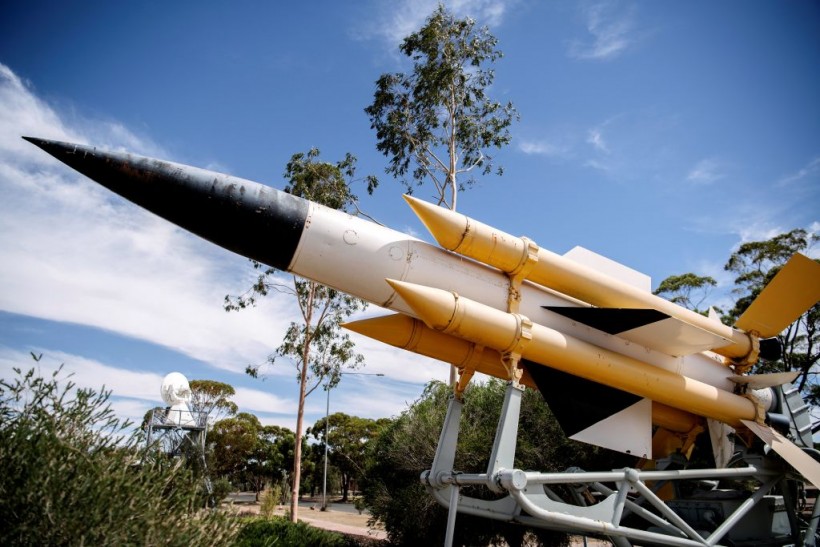The amount of rubbish is increasing in low-Earth orbit. This is due to the nearly 18,000 mph speed at which space junk made up of spent rocket boosters, and destroyed satellites and missiles hurtle through space.
When pieces of debris collide in low Earth orbit, it can put astronauts and spacecraft in danger, destroy operational satellites, or even set off a chain reaction that leads to the Kessler Syndrome, a deadly belt or cloud of congestion. NASA stated in 2016 that space junk is "the number one threat to spacecraft, satellites, and people."

This picture was taken on December 5, 2020, and shows the Bristol Bloodhound radar-guided surface-to-air missile in Woomera Village, some 488 kilometers northwest of South Australia's capital city of Adelaide.
Russian Missiles, Space Debris, Threatens Earth
The safety of satellites and their susceptibility to attacks from the ground are topics of national security discussions as the war in Ukraine rages. According to Wired, it is now more difficult to distinguish between satellite transmission problems caused by debris or Russian actors jamming communication signals to and from satellites.
In a Senate committee hearing last March (per Wired), US Space Command's commander General James Dickinson described commercial space systems as "an integral component of US critical infrastructure and fundamental to our national security."
According to him, recent developments in Ukraine show how vital services, like satellite internet access, can be provided by commercial space operations.
ALSO READ: China's Long March 5B Rocket Debris Found in the Philippines, Nearby Southeast Asian Countries
Space Junk Crashes More Likely to Happen
While it's possible that you haven't heard much about these crashes, the likelihood is high that you will see them in the future. Our low-Earth orbit roadways are getting crowded as the space economy grows. Because of this, space junk crashes on Earth are more likely.
"Even though all of outer space might be infinite, where we put satellites are very specific regions," astrodynamicist Moriba Jah tells ZDNET. "They're becoming more congested."
Jah, a chief scientist with Privateer, also aims to persuade the general public and policymakers that space should be treated with the same care and consideration as our land, sea, and air. He claims that space is a limited resource and should also be protected from environmental harm.
This means that businesses and governments that launch rockets or satellites into orbit need to develop responsible ways to manage everything that is still in orbit and return their decommissioned space debris to Earth.
Randomly falling space debris will continue to put Earthlings in danger of physical injury if that form of space stewardship is not practiced. Beyond that, space collisions can interfere with all aspects of daily living. A rising number of services, such as navigational aids, financial services, and communication tools, to name a few, depend on satellites to run.
Russia Launches Missile Amid Calls
Despite the warning, the Russian defense ministry's release of a video showing an intercontinental ballistic missile (ICBM) atop a silo launcher has been widely covered by the nation's media.
About the atomic bomb detonated in the Japanese city of Hiroshima on August 6, 1945, Komsomolskaya Pravda stated that the Yars missile complex, which was loaded in the Kaluga region, had a capacity that was "12 times bigger than the American bomb that destroyed Hiroshima."
The report in the widely read newspaper also described some of the missile's technical details, including its operational range of up to 12,000 kilometers, which allows it to target anywhere in Europe or the United States, and its payload capacity of up to 500 kilotons.
Newsweek, citing Military Today, said it weighs 49 tonnes or 49,000 kilos.
The preceding Topol-MR has been enhanced with the RS-24 Yars. The Moscow Institute of Thermal Engineering created the SS-29, which underwent its maiden test in 2007.
Reports also mentioned that it could be ready for launch in seven minutes and fired from a designated site, a customized garage with a sliding roof, or an unprepared position while in the field.
RELATED ARTICLE: After Accusing of Seizing Rocket Debris, Chinese Coast Guard Forcefully Takes the Remains From Philippine Navy in South China Sea
Check out more news and information on Space Debris in Science Times.




![Earth's Quasi-Moon Kamo‘oalewa Could Originate From Lunar Surface Not Asteroid Belt [Study]](https://1721181113.rsc.cdn77.org/data/thumbs/full/53275/89/56/50/40/earths-quasi-moon-kamo-oalewa-could-originate-from-lunar-surface-not-asteroid-belt-study.png)









